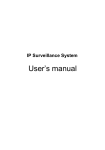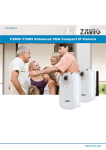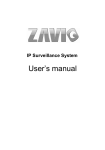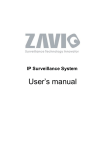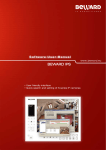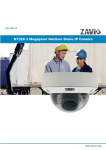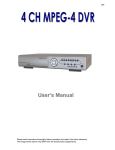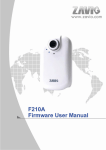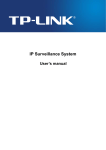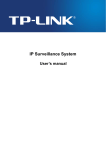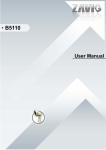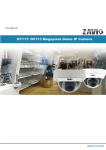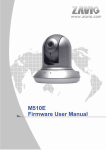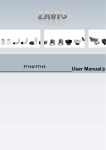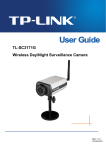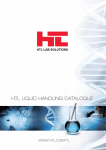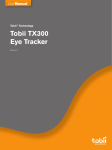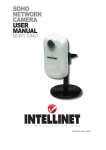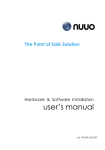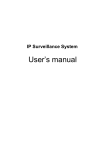Download Operations User Manual - Smart Security Systems
Transcript
Operations User Manual 16 channel Surveillance software included Built-in multi-zone motion and audio detection Table of contents Table of contents CHAPTER 1. SAFETY INSTRUCTIONS ............................................................................................................ 3 1.1. BEFORE YOU USE THIS PRODUCT ............................................................................................................... 3 CHAPTER 2. SYSTEM REQUIREMENTS AND PRODUCT FEATURES.......................................................... 5 2.1. SYSTEM REQUIREMENTS ........................................................................................................................... 5 2.2. PRODUCT FEATURES ................................................................................................................................. 6 CHAPTER 3. USING IP CAMERA VIA WEB BROWSER.................................................................................. 7 3.1. W INDOWS WEB BROWSER ......................................................................................................................... 7 3.2. MAC WEB BROWSER................................................................................................................................. 7 CHAPTER 4. USING IP CAMERA VIA MOBILE PHONE ................................................................................ 10 4.1. USING IP CAMERA VIA PHONE....................................................................................................................11 4.2.1. 3G Mobile Phone Streaming Viewing ........................................................................................................... 11 4.2.2. 2.5G Mobile Phone WAP Viewing ................................................................................................................. 11 4.2.3. 2.5G Mobile Phone Browser Viewing............................................................................................................ 11 CHAPTER 5. CONFIGURATION OF MAIN MENU .......................................................................................... 12 5.1. LIVE VIEW............................................................................................................................................... 12 5.1.1. Snapshot ....................................................................................................................................................... 12 5.1.2. Zoom in / out the image via the monitor window ........................................................................................ 13 5.1.3. Video Play Buttons ........................................................................................................................................ 13 5.1.4. Audio Buttons................................................................................................................................................ 14 5.2. SETTING ................................................................................................................................................. 14 5.3. CLIENT SETTING ...................................................................................................................................... 15 5.3.1. Mode............................................................................................................................................................. 15 5.3.2. View Size ....................................................................................................................................................... 15 5.3.3. Protocol......................................................................................................................................................... 15 5.3.4. Video Buffer .................................................................................................................................................. 15 5.4. IMAGE SETUP .......................................................................................................................................... 15 5.4.1. Brightness ..................................................................................................................................................... 15 5.4.2. Contrast......................................................................................................................................................... 16 5.4.3. Saturation ..................................................................................................................................................... 16 5.4.4. Hue................................................................................................................................................................ 16 5.4.5. Default .......................................................................................................................................................... 16 CHAPTER 6. SETTING-BASIC MENU............................................................................................................. 17 6.1. SYSTEM ................................................................................................................................................. 17 6.1.1. Information ................................................................................................................................................... 17 6.1.2. Date/Time ..................................................................................................................................................... 17 6.1.3. Initialize......................................................................................................................................................... 18 6.2. CAMERA ................................................................................................................................................. 19 6.2.1. General.......................................................................................................................................................... 19 6.2.2. MPEG-4 ......................................................................................................................................................... 21 6.2.2.1. Computer View........................................................................................................................................... 21 6.2.2.2. Mobile View ............................................................................................................................................... 22 6.2.3. MJPEG ........................................................................................................................................................... 23 6.3. NETWORK............................................................................................................................................... 24 6.3.1. Information ................................................................................................................................................... 24 6.3.2. PPPoE (Point-to-Point Protocol over Ethernet).............................................................................................. 25 6.3.3. DDNS (Dynamic DNS) .................................................................................................................................... 26 6.3.4. UPnP (Universal Plug and Play)..................................................................................................................... 30 6.3.5. Bonjour.......................................................................................................................................................... 31 6.3.6. IP notification................................................................................................................................................ 31 6.3.7. Wireless (only for N1250).............................................................................................................................. 33 6.4. SECURITY ............................................................................................................................................... 34 6.4.1. Account ......................................................................................................................................................... 35 6.4.2. HTTPS ............................................................................................................................................................ 35 CHAPTER 7. SETTING-ADVANCED MENU.................................................................................................... 37 7.1. FTP CLIENT ............................................................................................................................................ 37 N1000 Operations User Manual 1 Table of contents 7.1.1. General.......................................................................................................................................................... 37 7.1.2. Alarm Sending............................................................................................................................................... 38 7.1.3. Periodical Sending......................................................................................................................................... 39 7.2. SMTP.................................................................................................................................................... 40 7.2.1. General.......................................................................................................................................................... 40 7.2.2. Alarm Sending............................................................................................................................................... 42 7.2.3. Periodical Sending......................................................................................................................................... 43 7.3. HTTP EVENT .......................................................................................................................................... 44 7.4. SCHEDULE .............................................................................................................................................. 45 7.5. MOTION DETECTION ................................................................................................................................ 45 7.6. SYSTEM LOG........................................................................................................................................... 47 APPENDIX......................................................................................................................................................... 48 A. FRAME RATE AND BIT RATE TABLE ............................................................................................................ 48 B. STORAGE REQUIREMENT TABLE............................................................................................................... 49 C. TESTING SYSTEM SPECIFICATION............................................................................................................. 51 D. D1 PERFORMANCE OF 16 CHANNEL IP CAMERA........................................................................................ 51 EUROPE – EU DECLARATION OF CONFORMITY .................................................................................................. 52 FEDERAL COMMUNICATION COMMISSION INTERFERENCE STATEMENT ................................................................ 53 N1000 Operations User Manual 2 Chapter 1. Safety instructions Chapter 1. Safety instructions 1.1. Before you use this product This product has been designed with safety in mind. However, the electrical products can cause fires which may lead to serious body injury if not used properly. To avoid such accidents, be sure to heed the following: Legal Caution Video and audio surveillance can be forbidden by laws that vary from country to country. Check the laws in your local region before using this product for surveillance purposes; Do not open the housing of the product Do not try to open the housing or remove the covers which may expose yourself to dangerous voltage or other hazards; Do not use the accessories not recommend by the manufacturer Heed the safety precautions Be sure to follow the general safety precautions and the “Operation Notice”; Operation Notice - Operating or storage location Avoid operating or storing the camera in the following locations: • Extremely hot or cold places; • (Operating temperature: 0 °C to + 50 °C [32 °F to 122°F]); • Exposed to direct sunlight for a long time, or close to heating equipment (e.g., near heaters); • Close to water (e.g., near a bathtub, kitchen sink, laundry tub); • Close to sources of strong magnetism; • Close to sources of powerful electromagnetic radiation, such as radios or TV transmitters; • Locations subject to strong vibration or shock. In case of a breakdown In case of system breakdown, discontinue use and contact your authorized dealer. In case of abnormal operation: • If the unit emits smoke or an unusual smell; • If water or other foreign objects enter the cabinet; • If you drop the unit or damage the cabinet: 1 Disconnect the cable and the connecting cables. 2 Contact your authorized dealer or the store where you purchased the product. N1000 Operations User Manual 3 Chapter 1. Safety instructions Transportation When transporting the camera, repack it as originally packed at the factory or in materials of equal quality. Ventilation To prevent heat buildup, do not block air circulation around the device. Cleaning • Use a soft, dry cloth to clean the external surfaces of the device. Stubborn stains can be removed using a soft cloth dampened with a small quantity of detergent solution, then wipe dry. • Do not use volatile solvents such as alcohol, benzene or thinners as they may damage the surface. N1000 Operations User Manual 4 Chapter 2. System requirements and product features Chapter 2. System requirements and product features 2.1. System requirements We strongly recommend that the computer you have meets the following minimum requirements in order to use this IP Camera normally. If computer level is lower than this, it might cause problems of the IP camera usage. CPU: Pentium 4 1600MHz (or equivalent AMD) Graphic Card: 64 MB RAM graphic cards (or equivalent on-board graphic cards) RAM: 512 MB Operating System: Windows 98, Windows ME (Please see the Note below), Windows 2000, 2003, XP, Vista, Mac OS X Leopard Web Browser: Internet Explorer 6 or later NOTE! 1. If you use Windows 98 or Windows ME, please install IP Installer before using WEB UI to ensure the system runs normally. 2. If you cannot view the record video file, please install Xvid codec while installing Intelligent IP Installer. (For Windows 98, ME or 2000 server, the codec might not work properly. You will need to download Xvid codec 1.0 from the Internet. 3. Please always update the latest Windows components. (.Net Framework, Windows Media Player, Enhance ActiveX Security). N1000 Operations User Manual 5 Chapter 2. System requirements and product features 2.2. Product features SYSTEM Resolutions Compressing format Frame Rate MPEG-4 / Motion JPEG / JPEG: 2 resolutions from 640x480 to 320x240 via API and configuration web page MPEG-4 / Motion JPEG / JPEG MPEG-4: Up to 30 fps at 640x480 Motion JPEG: Up to 15 fps at 640x480 Rotation: Mirror, Flip, Mirror Flip Image settings Brightness / Contrast / Saturation / Hue Overlay capabilities: time, date, text and privacy image Shutter Time Image snapshot Video Recording Full Screen Viewing Digital Zoom Audio Mobile Phone Live View Alarm Sending Security Alarm and Event Management Supported protocols Simultaneous Connection Operating conditions 1/7.5 ~ 1/120 sec. Yes Yes Yes 10x digital Two-way (full / half duplex) with built-in microphone Audio compression: G.711 PCM, 8kHz, 64kbit/s Through 2.5 WAP, 3GPP, 3G Streaming, and 3G Browser FTP Client / SMTP Password Protection / HTTPS encryption / WEP64/128 bit, WPA/WPA2-PSK Input: motion diction Output: FTP/SMTP/HTTP Event Bonjour, TCP/IP, DHCP, PPPoE, ARP, ICMP, FTP, SMTP, DNS, NTP, UPnP, RTSP, RTP, HTTP, TCP, UDP, 3GPP/ISMA RTSP Up to 5 users 0°C ~ 50 ℃ (32℉ ~ 122 ℉) HARDWARE Lens LEDs / Working Distance Power Wireless N1000 Operations User Manual F2.0, 4.0mm board lens 5 φ LEDs x 6 / 5M (for N1250) 5V DC, 1A, Max 5W IEEE 802.11b/g (for N1250) 6 Chapter 3. Using IP camera via web browser Chapter 3. Using IP camera via web browser 3.1. Windows web browser Step 1: start your web browser, and enter the IP address or host name of the IP camera in the Location / Address field of your browser. NOTE! If you only want to view the video without making any settings, enter “http://<IP>/index2.htm” in address bar of your browser. Step 2: enter the default user name “admin” and default password “admin”. NOTE! The default user name “admin” and the password are set at the factory for the administrator. You can change them in the Account Menu (Please check “Setting → Basic → Security → Account”). Picture 3.1. Pic. 3.1 Step 3: the monitor image will be displayed in your browser. In the left side of main configuration window you can see Setting, Client Setting, and Image Setup menu. For more details see Chapter 5.2., Chapter 5.3. and Chapter 5.4. 3.2. MAC web browser Step 1: click the Safari icon, and enter the IP address of the IP camera in the Location / Address field of your browser. NOTE! If you only want to view the video without making any settings, enter “http://<IP>/index2.htm in the address bar of your browser. Picture 3.2. N1000 Operations User Manual 7 Chapter 3. Using IP camera via web browser Pic. 3.2 Step 3: use the default user name “admin” and default password “admin”. NOTE! The default user name “admin” and the password are set at the factory for the administrator. You can change them in the Account Menu (Please check “Setting → Basic → Security → Account”) Picture 3.3. Pic. 3.4 Step 4: image from the camera will be displayed in your browser. In the left side of main configuration you can find Setting, Client Setting, and Image Setup menu. For more details, you see Chapter 5.2, Chapter 5.3 and Chapter 5.4. Picture 3.4. N1000 Operations User Manual 8 Chapter 3. Using IP camera via web browser Pic. 3.4 N1000 Operations User Manual 9 Chapter 4. Using IP camera via mobile phone Chapter 4. Using IP camera via mobile phone You can use Web User Interface via iPhone. Please follow the setting process below. Then you can use web UI via iPhone. Step 1: tap Safari icon (Pic. 4.1). Pic. 4.1 Step 2: enter IP address in the address bar (Pic. 4.2). Pic. 4.2 Step 3: enter user name and password. Default values are admin / admin. Then click Login In. Picture 4.3. Pic. 4.3 N1000 Operations User Manual 10 Chapter 4. Using IP camera via mobile phone Step 4: the User Interface and live image will be displayed in the middle of screen. Picture 4.4. Pic. 4.4 NOTE! It will show continuous snapshots not a real time video streaming. Therefore, the recording feature is disabled. 4.1. Using IP camera via phone To use IP cameras via mobile phones, please make sure your RTSP is set to “On” (Default is “On”). To change the settings of IP cameras, please check Settings - Basic - Camera General. 4.2.1. 3G Mobile Phone Streaming Viewing For 3G mobile phone viewing, type “rtsp://<IP>:<PORT>/video.3gp” into your 3G Streaming Link. “IP” is the Public IP address of your IP camera; “PORT” is the RTSP port of your IP camera (Default value is 554.) Example: rtsp://100.10.10.1:554/video.3gp. NOTE! You can also use RTSP clients (RealPlayer, VLC, QuickTime layer…etc.) to view RTSP streaming, just type in “rtsp://<IP>:<PORT>/video.3gp” as the Player URL. 4.2.2. 2.5G Mobile Phone WAP Viewing For 2.5G mobile phone viewing, type “http://<IP>/mobile.wml ” into your 2.5G WAP Browser. “IP” is the Public IP address of your IP camera. 4.2.3. 2.5G Mobile Phone Browser Viewing For 2.5G mobile phone viewing, type “http://<IP>/mobile.htm ” into your 2.5G Web Browser. “IP” is the Public IP address of your IP camera. N1000 Operations User Manual 11 Chapter 5. Configuration of main menu Chapter 5. Configuration of main menu In the left side of main configuration window you can find “Setting”, “Client Setting” and “Image Setup” menu. In the right side of the picture below you can see the Live View screen of web user interface. There are some functions such as “Snapshot”, “Zoom” and “Audio” and “Video Play”. Picture 5.1. Snapshot Video Play Audio Button Full screen Zoom In/Out Pic. 5.1 5.1. Live View 5.1.1. Snapshot You can capture a still image shot by the camera and save it in your computer. Picture 5.2. Pic. 5.2 N1000 Operations User Manual 12 Chapter 5. Configuration of main menu 5.1.2. Zoom in / out the image via the monitor window Picture 5.3, 5.4. Pic. 5.3 Pic 5.4 Pic 5.5 Step 1: click to display the digital zoom in window. Step 2: pull to adjust the digital zoom range and it will be showed on the above window. Step 3: you can use left mouse button to move the anywhere on the window. 5.1.3. Video Play Buttons Symbols Meaning Pause the current video Play the video Stop the current video Record the current video N1000 Operations User Manual 13 Chapter 5. Configuration of main menu NOTE! Concerning the recording storage requirement of your hard disk, please refer to the APPENDIX B. Storage Requirement Table. 5.1.4. Audio Buttons Symbols Meaning Note means the speakers of your computer are turned on to transmit sound from the connected IP camera(s) Speakers turned on Speakers turned off means you can broadcast to the connected IP camera(s) via the Ethernet using your microphone Microphone turned on Microphone turned off Volume control bar 5.2. Setting This function is only for the Administrator. Click this button to get into the Basic and Advanced Setting menu. The former includes for sub-folders, such as System, Camera, Network, and Security. The latter includes FTP Client, SMTP, Http Event, Schedule, Motion Detection, and System Log. Picture 5.6. Pic. 5.6 N1000 Operations User Manual 14 Chapter 5. Configuration of main menu 5.3. Client setting This function is only for the client. Picture 5.7. Pic. 5.7 Click this button to control Mode, View Size, Protocol, and Video Buffer. 5.3.1. Mode Click the pull-down box to choose between MPEG-4, MJPEG, and JPEG video compression mode. MJPEG streaming is unavailable if RTSP mode is “On.” (Please check Setting - Basic - Camera – General). 5.3.2. View Size Select the desired display image resolution to 640X480 or 320X240. 5.3.3. Protocol Select the transferring protocol from TCP, UDP, HTTP and Multicast. 5.3.4. Video Buffer Turn the Video Buffer function On/Off. The Video Buffer function makes the streaming more smooth in unsteady network environment, but might cause a little delay in live viewing. 5.4. Image setup You can use the tool bar to optimize video Brightness, Contrast, Saturation and Hue. 5.4.1. Brightness The higher value the brightness is, the brighter the image is. N1000 Operations User Manual 15 Chapter 5. Configuration of main menu 5.4.2. Contrast The contrast is a measure of a display system, defined as the ratio of white to black that the system is capable of producing. The higher value the contrast is, the more delicate of color you can have. 5.4.3. Saturation The saturation of a color is determined by a combination of light intensity and how much it is distributed across the spectrum of different wavelengths. The higher value the saturation is, the more colorful the image will be. 5.4.4. Hue Hue is one of the three main attributes of perceived color, affected by different wavelength of color. With higher value of hue, color will be much more vivid. 5.4.5. Default After the adjustment of all setting, you can still click Default to make the setting back to the original setting. N1000 Operations User Manual 16 Chapter 6. Setting-basic menu Chapter 6. Setting-basic menu Click the Basic menu to display the submenu including “System”, “Camera”, “Network”, and “Security”. 6.1. System Click the System menu to display the submenu including “Information”, “Date / Time”, and “Initialize”. 6.1.1. Information The Information page provides the product factory information which includes “Product Name”, “Firmware Version” and “Web Version”. Picture 6.1. Pic. 6.1 6.1.2. Date/Time The Date/ Time page displays all options of time setting. Picture 6.2. Pic. 6.2 N1000 Operations User Manual 17 Chapter 6. Setting-basic menu Current Date / Time: this displays the current date and time of this IP Camera. PC Clock: this displays the date and time of the monitoring PC clock. Date / Time Format: you can click the pull down box to select different time display formats. Adjust: you can select one of those four adjusting modes for your IP Camera. • Keep current setting: select this mode to keep the current date and time of this IP Camera. • Synchronize: select this mode to keep the date and time of this IP Camera the same as the monitoring PC. • Manual setting: select this mode to adjust manually the date and time of this IP Camera. • Synchronize with NTP: specify the NTP server name and the Refresh Interval to synchronize the date and time of this IP Camera with those of the time server, known as the NTP server. Time Zone: you can select the Time Zone of the format from Greenwich Mean Time. The time will display the same as the current date / time option. Daylight Saving Time: there are two modes to choose for setting up daylight saving time. By Date: set the start and end time by select month, day, hour, and minute. By Week Number: set the start and end time by select month, week, hour, and minute. NOTE! The NTP server (Network Time Protocol) is the time server which is an Internet standard protocol built on the top of TCP / IP. This assures accurate synchronization to the millisecond of computer clock times in a network of computers. 6.1.3. Initialize Picture 6.3. Pic. 6.3 Reboot: click this button to reboot. A confirmation dialogue will appear and then click “OK” to process. It takes two minutes to reboot this IP Camera. N1000 Operations User Manual 18 Chapter 6. Setting-basic menu Factory Default: click this button to reset this IP Camera to the factory default setting. A confirmation dialogue will appear and then click “OK” to process. Do not turn off this IP Camera until the device reboots. Backup Setting: you can save the setting data of this IP Camera into a file. Click “Save” and follow the instructions on the browser to save the setting data file to your specified location. Restore Setting: download the saved setting data of this IP Camera. Click “Browse” and select saved file. Click “OK” and this IP Camera will be adjusted according to the loaded data and then restarted. Firmware Update: upgrade the device software. Click “Browse” and select the file for upgrading. A confirmation dialogue will appear. Click “OK” to start upgrading. The IP camera will reboot to complete the update. NOTE! Use only upgrade files that are special for this IP Camera. Otherwise problems may occur. Do not turn off the IP Camera power or disconnect the network until the upgrading is completed. NOTE! After upgrading new firmware, please execute “Factory Default” first to make it work. Upload Language Pack: upgrade the device language pack. Click “Browse” and select the file for upgrading. A confirmation dialogue will appear. Click “OK” to start upgrading. The upgrade is applied immediately. The default language is “English.” 6.2. Camera Click the Camera menu to display the submenu including “General”, “MPEG4” and “MJPEG.” 6.2.1. General Picture 6.4 Pic. 6.4 N1000 Operations User Manual 19 Chapter 6. Setting-basic menu RTSP: switch RTSP “On” or “Off.” The default value is 554. NOTE! RTSP (Real Time Streaming Protocol) is a protocol for use in streaming media system which allows clients to remotely control a streaming video server. RTSP is supported by most of the media clients such as Real Player, QuickTime, VLC, etc. Image Rotate: you can mirror or flip the display screen. Audio Codec: if this option is turned On, the microphone will start sound reception. Night Mode: you can choose Auto / Off. If you choose Auto option, the camera will be adjusted automatically to perform well when the environment is dark. Lighting: you can choose the environment among 50 Hz, 60 Hz, and Auto. White Balance: you can choose the white balance to Auto, Florescent, Incandescent and Black & White. LED (only for N1250): you can turn LED light On / Off and Auto. If you select Auto mode, you can adjust threshold for LED Auto-On and Auto-Off respectively. In the right side of threshold, if the tool bar is closer to the right, the LED will auto-on easily in the dark environment. Conversely, in the left side of threshold, if the tool bar is more approach to the left, the LEDs will auto-off easily in the bright environment. NOTE! LED will light up after 10 seconds in dark environment. Overlay: • Text Overlay: you can see some information on the display screen which includes Date / Time and user-defined text. Also, you can change the background color. • Privacy Mask: you can cover a specific area of the video image. N1000 Operations User Manual 20 Chapter 6. Setting-basic menu 6.2.2. MPEG-4 6.2.2.1. Computer View. Picture 6.5. Pic. 6.5. If RTSP is ON, the option of Viewer Authentication & Multicast Streaming will appear. (Please check “Setting - Basic - Camera - General”) Viewer Authentication: if the viewer authentication is “On”, the users will be requested to enter username and password when viewing through RTSP. Multicast Streaming (If it is on): • Multicast Address: specify the multicast server address. • Video / Audio Port: specify the transmission port number of the video data. Specify an even number from 1024 to 65534. • Time to Live: set the maximum TTL that multicast can pass through. Specify the value from 1 to 255. Image Size: specify the image size which the network camera should transmit. You can choose among 640 x 480, 320 x 240, and 160 x 120. Frame Rate: set the frame rate of the MPEG4 image. You can choose values from 1, 2, 3, 4, 5, 7, 10, 15, 20, 25, and 30 fps. The unit “fps” stands for “frames per second”. Quality: • Auto: the quality and bit rate will be adjusted automatically according to the frame rate. • Fixed Quality: you can select the value of quality among Medium, Standard, Good, Delicate and Excellent. • Fixed Bit rate: set the bit rate of MPEG4 image transmission for a line. You can select the value from 64, 128, 256, 384, 512, 768, 1024, 1280, 1536, and 2048 kbps. N1000 Operations User Manual 21 Chapter 6. Setting-basic menu NOTE! Concerning how to select the suitable image quality for Fixed Quality or Fixed Bit rate, please refer to the APPENDIX A. Frame-rate & Bit rate Table. 6.2.2.2. Mobile View. Picture 6.6. Pic. 6.6 If RTSP is ON, the option of Viewer Authentication & Multicast Streaming will appear. (Please check “Setting - Basic - Camera - General ”) NOTE! If RTSP is off, Mobile View will be disabled. Viewer Authentication: if the viewer authentication is On, the users will be requested to enter username and password when viewing through RTSP. Multicast Streaming (If it is on): • Multicast Address: specify the multicast server address. • Video / Audio Port: specify the transmission port number of the video data. Specify an even number from 1024 to 65534. • Time to Live: set the maximum TTL that multicast can pass through. Specify the value from 1 to 255. Image Size: the image size of Mobile View is fixed at 320x240 or 160x120. Frame Rate: set the frame rate of the MPEG4 image. You can choose values from 5 and 10 fps. The unit “fps” stands for “frames sent per second”. N1000 Operations User Manual 22 Chapter 6. Setting-basic menu Quality: • Auto: the quality and bitrate will be adjusted automatically according to the frame rate. • Fixed Quality: you can select the value of quality among Medium, Standard, Good, Delicate and Excellent. • Fixed Bit rate: set the bit rate of MPEG4 image transmission for a line. You can select the value from 16, 32, 48, 64, 128, and 256 kbps. NOTE! Concerning how to select the suitable image quality for Fixed Quality or Fixed Bit rate, please refer to the APPENDIX / A. Frame-rate & Bit rate Table. 6.2.3. MJPEG Picture 6.7. Pic. 6.7 If RTSP is OFF, the option of Image Size & Frame Rate & Quality will appear. (Please check “Setting - Basic - Camera - General”) Image Size: specify the image size which the network camera should transmit. You can choose among 640x480, 320x240, and 160x120. Frame Rate: set the frame rate of the MJPEG image. You can choose values from 1, 2, 3, 4, 5, 7, 10, and 15 fps. The unit “fps” stands for “frames per second”. Quality: • Auto: the quality will be automatically decided. • Fixed Quality: you can select the value of quality among Medium, Standard, Good, Delicate and Excellent. NOTE! Concerning how to select the suitable image quality for Fixed Quality or Fixed Bit rate, please refer to the APPENDIX / A. Frame-rate & Bit rate Table. N1000 Operations User Manual 23 Chapter 6. Setting-basic menu 6.3. Network Click the Network menu to display the submenu including “Information”, “PPPoE”, “DDNS”, “UPnP”, “Bonjour”, “IP Notification”, “Wireless (for wireless models)”. 6.3.1. Information Displays the MAC address of the device. Picture 6.8. Pic. 6.8 Pic. 6.9 Obtain an IP address automatically (DHCP): if a DHCP server is installed on the network, select this while the IP address is assigned by the DHCP server (Pic. 6.9). Obtain DNS server address automatically: select this to obtain the address of DNS server automatically (Pic. 6.9). N1000 Operations User Manual 24 Chapter 6. Setting-basic menu Use the following IP address: select this when the fixed IP address is set. • IP address: enter the IP address of the device; • Subnet mask: enter the subnet mask; • Default gateway: enter the default gateway; Use the following DNS server address: select this when you set the fixed address as the IP address of DNS server. • Primary DNS server: enter the IP address of the primary DNS server; • Secondary DNS server: enter the IP address of the secondary DNS server, if necessary. HTTP port number: select 80 in general situations. If you want to use a port number other than 80, select the text box and enter a port number between 1024 and 65535. When you have set the HTTP port number to a number other than 80 on the Network setting page or in the Setup Program, access the device by typing the IP address of the device on the web browser as follows: Example: when HTTP port number is set to 2000 http://192.168.1.100:2000/ NOTE! The IP Camera needs to be rebooted after it finishes changing the network setting completely. NOTE! If you connect the IP Camera with your computer directly, the default network domain of camera is 192.168.1.xx 6.3.2. PPPoE (Point-to-Point Protocol over Ethernet) If your ISP provides Dynamic IP with authentication by username and password, type all PPPoE information in this part. When you use the PPPoE function, you need to turn on the DDNS or IP Notification function at same time. Picture 6.10. Pic. 6.10 IP Address: the IP address obtained at the PPPoE connecting with network. N1000 Operations User Manual 25 Chapter 6. Setting-basic menu User ID: enter the user ID for authentication necessary for PPPoE connections. Type it up to 64 characters. Password: enter the password for authentication necessary for PPPoE connections. Type it up to 32 characters. Re-type Password: re-type the password to confirm. Obtain DNS server address automatically: select this to obtain the address of DNS server automatically. Use the following DNS server address: select this when you set the fixed address as the IP address of DNS server: • Primary DNS server: enter the IP address of the primary DNS server; • Secondary DNS server: enter the IP address of the secondary DNS server. NOTE! 1. PPPoE (Point-to-Point Protocol over Ethernet): PPPoE is a network protocol for encapsulating Point-toPoint Protocol frames insider Ethernet frames. PPPoE connection is used mainly with ADSL service where individual users connect to the ADSL transceiver (modem) over Ethernet work. It also widely used in XDSL. (digital affiliate line such as ADSL, VDSL or SDSL) 2. The IP Camera needs to be rebooted after changing of the network parameters is completed. 3. The IP Camera with Intelligent IP Installer cannot be founded in network after turning on the PPPoE and reboot. 6.3.3. DDNS (Dynamic DNS) Picture 6.11. Pic. 6.11 N1000 Operations User Manual 26 Chapter 6. Setting-basic menu DDNS is a system which allows the domain name data held in a name server to be updated in real time. The most common use for DDNS is allowing an internet domain name to be assigned to a computer with a varying / dynamic IP Address. This makes it possible for other sites on the Internet to establish connection to the machine without need to track the IP Address themselves. Server name: choose the DDNS Server from the list. User ID: enter the user ID for authentication necessary for DDNS connections. Type it up to 64 characters. Password: enter the password for authentication necessary for DDNS connections. Type it up to 32 characters. Re-type password: re-type the password to confirm. Host name: enter the host name that is registered to the DDNS server. How to apply DDNS username and Host name? You can apply DDNS username and Host name by the following steps: Step 1: login http://www.dyndns.org, click the Create Account link (Pic. 6.12). Pic. 6.12 N1000 Operations User Manual 27 Chapter 6. Setting-basic menu Step 2: input all information and follow step by step with DynDNS (Pic. 6.13). Pic. 6.13 Step 3: log in with new account and click Account - My Hosts - Add Host Services. Picture 6.14. Pic. 6.14 N1000 Operations User Manual 28 Chapter 6. Setting-basic menu Step 4: enter domain in the Hostname field and select sub-domain (Pic. 6.15). Pic. 6.15 Step 5: after entering all the information, check your DDNS service (Pic. 6.16). Pic. 6.16 N1000 Operations User Manual 29 Chapter 6. Setting-basic menu Step 6: type your DDNS User ID, Password and Host name in Setting - Network - DDNS. After completing setting, reboot IP Camera (Pic. 6.17). Pic. 6.17 6.3.4. UPnP (Universal Plug and Play) You can turn UPnP function “On” or “Off” (Pic. 6.18). Pic 6.18 If a router is used to access to the Internet and it supports UPnP IGD function, please turn on the UPnP Port Forwarding function (Pic. 6.19). Pic. 6.19 HTTP port: the default HTTP port is 80. Or the port number can be entered, ranged from 1024 to 65535. SSL port: the default SSL port is 443. Or the port number can be entered, ranged from 1024 to 65535. N1000 Operations User Manual 30 Chapter 6. Setting-basic menu MPEG4 RTSP port: the default MPEG-4 RTSP Port is 554. Or the port number can be entered, ranged from 1024 to 65535. NOTE! UPnP (Universal Plug and Play): UPnP is a set of computer network protocol. It allows devices to connect seamlessly and simplify the implementation of networks in the home and corporate environments. The device supports UPnP which is enabled by default. The device will be automatically detected and a new icon will be added to “My Network Place” if it is also enabled on your computer. It provides Port Forwarding for opening a port in a router or firewall in a private network in order to let a party from the outside world contact an inside user. 6.3.5. Bonjour Bonjour, also known as zero-configuration networking, enables automatic discovery of computers, devices, and services on IP networks. Bonjour uses industry standard IP protocols to allow devices to automatically discover each other without need to enter IP addresses or configure DNS servers (Pic. 6.20). Pic. 6.20 Device Name: enter Device Name you wish. NOTE! To learn how to use Bonjour in your Windows Browser UI go to http://www.apple.com/support/downloads/bonjourforwindows.html 6.3.6. IP notification When network notify type is set to “ON”, you can send an e-mail notification of the completion of the network setting (Pic. 6.21). N1000 Operations User Manual 31 Chapter 6. Setting-basic menu Pic. 6.21 Notify Type: you can select the notify type among DHCP, Static IP, and PPPoE. SMTP Server Name: type the SMTP server name up to 64 characters, or the IP address of the SMTP server. SMTP Server Port: you can set port number from 1~65535 according to your mail server. The default value is 25. • Security setting: check SSL box if the mail server you use has security restriction. NOTE! If you use Gmail as your mail server, you should set 587 as your port number and tick SSL box. Authentication: select the authentication required when you send an email. • Off: Select if no authentication is necessary when an email is sent; • On: When authentication is necessary an e-mail is sent, there are SMPT, POP before SMPT or both three options. SMTP: select if SMTP authentication is necessary when an e-mail is sent. POP before SMTP: select if POP before SMTP authentication is necessary when an e-mail is sent. POP server name: it is necessary when the POP before SMTP is selected in Authentication. Type the POP (receiving mail) server name up to 64 characters, or type the IP address of the POP server. This setting is necessary when the SMTP server which sends e-mails performs authentication using the POP user account. User name, Password: enter the user name and password of the user who has the mail account. This setting is necessary when the SMTP server which sends e-mails performs authentication. Recipient e-mail address: enter the recipient e-mail address up to 64 characters. You can specify up to three recipient e-mail addresses. N1000 Operations User Manual 32 Chapter 6. Setting-basic menu Administrator e-mail address: type the Administrator e-mail address up to 64 characters. This address is used for reply mail and sending system messages from the SMTP server. Subject: type the subject/title of the e-mail up to 64 characters. With respect to mail which is sent according to the IP notification. Message: type the text of the e-mail up to 384 characters. Default value provides network information including “IP”, “Port”, “MAC”, “Model”, “Firmware Version” and “Web Version”. 6.3.7. Wireless (only for N1250) The wireless network has to be set up by using cable network connection. After setting the camera correctly, the wireless function can work with cable network connection. Wireless settings must be the same as the access point or ad-hoc device. When changing the settings they should always be made first in the camera and then in the wireless access point. This ensures that the camera is always accessible when making changes (Pic. 6.22). Pic. 6.22 Status of Wireless Network: this list is the result of network scan. The network is currently linked to will be shown in blue. The following information is provided. • ESSID - The name of a wireless network (or ad-hoc device). If the same name occurs several times this means that several access points for that network were found. The camera cannot be configured to only associate with one particular access point. N1000 Operations User Manual 33 Chapter 6. Setting-basic menu • Mode - Shows if the network type is Master (access point or router) or Ad-Hoc (another client). • Security - Shows which type of security the network uses. See below for the security types supported by the camera. • Channel - Shows the wireless channel currently in use. • Signal strength - Shows the signal strength. • Bit rate - Shows the bit rate in Megabit/s. This can only be shown for the access point currently in use. Note that the bit rate shown is the current rate, and that this value may vary over time. Wireless Setting: these settings control how the camera interacts with the wireless network. It is also possible to enable wireless encryption apart from identifying the wireless network. • IP Address – This displays blank, 0.0.0.0 or IP Address. When it is blank, the camera does not establish physical link with access point yet. The 0.0.0.0 means that physical link was established but trying to get IP address. When it displays IP address, user can use wireless network. • ESSID (ESSID is sometimes written as SSID.) - This is the name of the wireless network the camera is configured for. The field accepts up to 32 alphanumeric characters. The name must be exactly the same as that used in the wireless access point or the connection will not be established. • Leaving this field blank means the camera will attempt to access the nearest open network. • Mode - Setting this to Managed means the camera will attempt to access the nearest open access point. The Ad-hoc option allows the camera to connect to other wireless devices clients. NOTE! 1. WPA-/WPA2-PSK (Wi-Fi Protected Access - Pre-Shared Key) the camera uses a pre-shared key (PSK) to initiate WPA security. The pre-shared key is entered on the access point and on each device on the wireless network. The key can be entered either as Manual hex, as 64 hexadecimal (0-9, A-F) characters, or as a Passphrase, using 8 to 63 ASCII characters. The access point keeps out unauthorized users by requiring the key to communicate. 2. WEP (Wired Equivalent Protection) the original security standard used in wireless networks that provides a minimal level of security that can deter minor trespasses. The administrator can select the key length among 64 or 128 bits. 64bits is the default setting. 6.4. Security Click the Security menu to display the submenu including “Account and HTTPS”. N1000 Operations User Manual 34 Chapter 6. Setting-basic menu 6.4.1. Account The device default account and password are “admin / admin”. That means everyone who knows IP address can access the device including all configuration. It is necessary to assign a password if the device is intended to be accessed by others (Pic. 6.25). Pic. 6.25 User name: set a user name between 4-16 characters. Password: set a password between 4-16 characters. Re-type Password: re-type the password to confirm. Viewer Mode: set the user mode among Admin, Operator, and Viewer. Different viewer mode has different limits of authority. • The Admin mode has all authority of configuration; • The Operator mode can not only view the Live View but also control the PTZ (apply in speed dome); • The Viewer mode only can view the Live View. Viewer Authentication: allows any viewer direct access to Live View. 6.4.2. HTTPS HTTPS is a URI scheme used to indicate a secure HTTP connection. It is syntactically identical to the http://scheme normally used for accessing resources using HTTP. Using an https: //URL/ with a different default TCP port (443) and an additional encryption / authentication layer between the HTTP and TCP. You can use the IP camera through HTTPS easily by using https:// instead of http://. Picture 6.26. N1000 Operations User Manual 35 Chapter 6. Setting-basic menu Pic. 6.26 Create & Install: create a self-signed certificate for HTTPS for recognition. Installed Certificate: display or remove the properties of the installed certificate. HTTPS Connection Policy: set HTTPS connection policy for different level of users. To use the HTTPS encryption, please set up “Create self-signed certificate” for the first time you use the HTTPS function, and then set up the connection policy for different users. Picture 6.27. Pic.6.27 NOTE! When enable HTTPS with RTSP on mode, the IP Camera only protects the setting such as username and password and does not protect video and audio. When enable HTTPS with RTSP off mode, the IP Camera will protect all setting including video and audio. N1000 Operations User Manual 36 Chapter 8. Setting-advanced menu Chapter 7. Setting-advanced menu Click the Advance menu to display the submenu including “FTP client”, “SMTP”, “Schedule”, “Motion detection” and “System Log”. 7.1. FTP client Use this menu to set up for capturing and sending images to an FTP server. By using FTP client function, you can send the image file which has been shot and recorded linked with the builtin motion detection function to FTP server. FTP client setting menu is composed of two tabs, General, Alarm sending and Periodical sending. 7.1.1. General Picture 7.1. Pic. 7.1 Select “On” when you use FTP function. The FTP client setting page appears. Select “Off”, when you do not wish to use the FTP client function. NOTE! The frame rate and operability on the main viewer may be decreased while a file is being transmitted by the FTP client function. FTP server name: type the FTP server name to upload still images up to 64 characters, or the IP address of the FTP server. User name: type the user name for the FTP server. Password: type the password for the FTP server. Retype password: to confirm the password, type the same characters as you typed in the Password box. N1000 Operations User Manual 37 Chapter 7. Setting-advanced menu Passive mode: set whether you use the passive mode of FTP server or not when connecting to FTP server. Select “On” to connect to FTP server using the passive mode. 7.1.2. Alarm Sending Set to forward the image file to the specified FTP server linked with the alarm detection by the built-in motion detection function. Select “On” to send the image file to FTP server linked with the alarm detection (Pic. 7.2). Pic. 7.2 Remote Path: type the path to the destination in FTP server up to 64 characters. Image File Name: type the file name you want to assign to the images when sending to the FTP server. You can use up to 10 alphanumeric characters, - (hyphen) and _ (underscore) for naming. Suffix: select a suffix to add to the file name. • Date & time: the date & time suffix is added to the Image file name. The date/time suffix consists of lower two-digits of year (2 digits), month (2 digits), date (2 digits), hour (2 digits), minute (2 digits), second (2 digits), and consecutive number (2 digits), thus 14-digit number is added to the file name. • Sequence number: a consecutive number of 10 digits between 0000000001 and 4294967295 and two fixed digits 00 are added to the Image file name. • Sequence number clear: Click [Clear] and the suffix of the sequence number returns to 1. Alarm • Motion Detection: click it on for using Motion Detection function as a sensor. You can set motion detection function at the motion detection function page. N1000 Operations User Manual 38 Chapter 7. Setting-advanced menu NOTE! You can set motion detection at motion detection page. (Please go “Setting - Advance - Motion Detection - Setting”) Effective period: set the period when the periodical sending is effective. Always: the periodical sending is always effective. Schedule: you can specify the period when the periodical sending is effective in the Schedule setting in the other section. NOTE! You can set schedule function at the schedule page. (Please go “Setting - Advance - Schedule Setting”) 7.1.3. Periodical Sending You can set to send an image file to FTP server periodically by selecting “On” to send the image file to FTP server linked with setting period (Pic. 7.3). Pic. 7.3 Image file name: type the file name of the image sent by SMTP up to 10 alphanumeric characters, - (hyphen) and _ (underscore). Suffix: select a suffix to be added to the file name sent by SMTP. • None: the name of the sent file will be the Image file name. • Date & time: the date & time suffix is added to the Image file name. The date & time suffix consists of lower two-digits of year (2 digits), month (2 digits), date (2 digits), hour (2 digits), N1000 Operations User Manual 39 Chapter 7. Setting-advanced menu minute (2 digits) and second (2 digits), and consecutive number (2 digits), thus 14-digit number is added to the file name. • Sequence number: a consecutive number is added to the Image file name. • Sequence number clear: click [Clear] and the suffix of the sequence number returns to 1. Interval: set the effective interval of periodical sending. Min value is 1 min and Max value is 24 hour. Effective period: set the period when the periodical sending is effective. • Always: the periodical sending is always effective. • Schedule: you can specify the period when the periodical sending is effective in the Schedule setting in the other section. NOTE! You can set schedule function at the schedule page. (Please go “Setting → Advance → Schedule → Setting”) 7.2. SMTP Set the SMTP menu when you want to send an image via e-mail. By using Mail (SMTP) function, you can send a mail with attached image file which has been shot linked with the external sensor input or with the built-in motion detection function. The image file can also be sent periodically. E-Mail (SMTP) setting menu is composed of three tabs, “General”, “Alarm sending” and “Periodical sending”. 7.2.1. General Select “On” when you use the SMTP function. The common setting options are displayed below. Select “Off”, if you do not wish to use the e-mail (SMTP) function. Picture 7.4. NOTE! The setting of general part will be the same as the setting of IP Notification (Please check “Setting - Basic - Network - IP Notification”). N1000 Operations User Manual 40 Chapter 7. Setting-advanced menu Pic. 7.4 SMTP server name: enter the SMTP server name up to 64 characters, or the IP address of the SMTP server. SMTP Server Port: you can set port number from 1~65535 according to your mail server. The default value is 25. • Security setting: check SSL box if the mail server you use has security restriction. NOTE! If you use Gmail as your mail server, you should set 587 as your port number and tick SSL box. Authentication: select the authentication required when you send an email. • Off: select if no authentication is necessary when an email is sent; • On: when authentication is necessary an e-mail is sent, select one of the authentication methods from the followings. SMTP: select if SMTP authentication is necessary when an e-mail is sent. POP before SMTP: select if POP before SMTP authentication is necessary when an e-mail is sent. NOTE! When you set to On, be sure to select either or both SMTP or / and POP before SMTP. • POP server name: it is necessary when the POP before SMTP is selected in Authentication. Enter the POP (receiving mail) server name up to 64 characters, or type the IP address of the POP server. This setting is necessary when the SMTP server which sends e-mails performs authentication using the POP user account. N1000 Operations User Manual 41 Chapter 7. Setting-advanced menu • User name, Password: type the user name and Password of the user who has the mail account. This setting is necessary when the SMTP server which sends e-mails performs authentication. Recipient e-mail address: enter the recipient e-mail address up to 64 characters. You can specify up to three recipient e-mail addresses. Administrator e-mail address: enter the Administrator e-mail address up to 64 characters. This address is used for reply mail and sending system messages from the SMTP server. Subject: enter the subject/title of the e-mail up to 64 characters. With respect to mail which is sent according to the alarm detection when Alarm sending of the alarm tab is set to “On”, the characters standing for the sensor type added to the subject. Message: enter the text of the e-mail up to 384 characters. (A line break is equivalent to 2 characters.) 7.2.2. Alarm Sending Set to send the mail with connection to the alarm detection by the built-in motion detection function. Select “On” to send the image file to SMTP server linked with the alarm detection. Picture 7.5. Pic. 7.5 Alarm sending: select “On” to set to send mail with connection to the alarm detection. File attachment: set whether an image file is attached to the mail sent or not. When “On” is selected, the image file made by the settings below is attached. When “Off” is selected, only the message is sent. Image file name: enter the file name you want to assign to the image to attach a mail. You can use up to 10 alphanumeric, - (hyphen) and _ (underscore) for naming. Suffix: select a suffix to add to the file name. N1000 Operations User Manual 42 Chapter 7. Setting-advanced menu • Date & time: the date & time suffix is added to the Image file name. The date/time suffix consists of lower two-digits of year (2 digits), month (2 digits), date (2 digits), hour (2 digits), minute (2 digits), second (2 digits), and consecutive number (2 digits), thus 14-digit number is added to the file name. • Sequence number: a consecutive number of 10 digits between 0000000001 and 4294967295 and two fixed digits 00 are added to the Image file name. • Sequence number clear: click [Clear] and the suffix of the sequence number returns to 1. Alarm • Motion Detection: click it on for using Motion Detection function as a sensor. You can set motion detection function at the motion detection function page. NOTE! You can set motion detection at the motion detection page. (Please go “Setting - Advance - Motion detection - Setting”). Effective period: set the period when the periodical sending is effective. Always: the periodical sending is always effective. Schedule: you can specify the period when the periodical sending is effective in the Schedule setting in the other section. NOTE! You can set schedule function at schedule page. (Please go “Setting - Advance - Schedule - Setting”). 7.2.3. Periodical Sending You can set to send an image file by SMTP server periodically by selecting “On” to send the image file by SMTP server linked with setting period. Picture 7.6. Pic. 7.6 N1000 Operations User Manual 43 Chapter 7. Setting-advanced menu Image file name: type the file name of the image sent by SMTP up to 10 alphanumeric characters, - (hyphen) and _ (under score). Suffix: select a suffix to be added to the file name sent by SMTP. None: the name of the sent file will be the Image file name. Date & time: the date & time suffix is added to the Image file name. The date & time suffix consists of lower two-digits of year (2 digits), month (2 digits), date (2 digits), hour (2 digits), minute (2 digits) and second (2 digits), and consecutive number (2 digits), thus 14-digit number is added to the file name. Sequence number: a consecutive number is added to the Image file name. Sequence number clear: click [Clear] and the suffix of the sequence number returns to 1. Interval: set the periodical sending is effective interval. Min value is 30 min and Max value is 24 hour. Effective period: set the period when the periodical sending is effective. Always: the periodical sending is always effective. Schedule: you can specify the period when the periodical sending is effective in the schedule setting in the other section. Please check “Setting - Basic - Advance - Schedule Setting.” NOTE! You can set schedule function at schedule page. (Please go “Setting - Advance - Schedule - Setting”) 7.3. HTTP event Set up this menu for sending commands to an HTTP server. By using HTTP client function, you can send the command defined by yourself, linked with the external sensor input or with the built-in motion detection function to HTTP server. HTTP Event setting menu is composed of two tabs, “General” and “Alarm sending”. Select “On”, and you can start setting up the function. Picture 7.7. Pic. 7.7 N1000 Operations User Manual 44 Chapter 7. Setting-advanced menu 7.4. Schedule When you click “Schedule” on the Advance mode menu, the Schedule setting menu appears. This is the same menu as the setting menu which is displayed when you click “Schedule” to set Effective period and Schedule in FTP client setting menu, and E-Mail (SMTP) setting menu Picture. 7.8. Example: when setting e-mail (SMTP) (the alarm sending) in the Schedule setting menu. Pic. 7.8 Schedule Selection: select the list box to specify the schedule you want to set. • FTP -Alarm ; • FTP – Periodical’ • E-Mail (SMTP) -Alarm ‘ • Email (SMTP) –Periodical. Mon (Monday) to Sun (Sunday): the time period on the right of the checked day is the effective period of the schedule. Start time, End time: specify the Start time and the End time. Use the same time schedule every day: when this is checked, the Start time and End time set to Mon (Monday) are applied to all days. In this case, the Start time and End time of the other days than Mon (Monday) cannot be input. 7.5. Motion detection There are three Motion Detection functions as sensors to set for different detecting zones. Each one has Threshold and Sensitivity inputs which you can adjust to specific zone sequentially. Motion Detection function can support FTP, SMTP and Alarm output for capturing and sending images or starting alarm output. Picture 7.9. N1000 Operations User Manual 45 Chapter 7. Setting-advanced menu Pic. 7.9. Threshold: it means the extent which the alarm will be triggered. Sensitivity: it means that how often the sensor will scan the image different. The higher sensitivity it is and the more frequently it scans. • Motion Detection 1: click it on for using Motion Detection 1 function as a sensor. You can adjust and move the detecting zone by using mouse. • Motion Detection 2: click it on for using Motion Detection 2 function as a sensor. You can adjust and move the detecting zone by using mouse. • Motion Detection 3: click it on for using Motion Detection 3 function as a sensor. You can adjust and move the detecting zone by using mouse. N1000 Operations User Manual 46 Chapter 7. Setting-advanced menu 7.6. System log The System Log function allows users to review any changes and events happened. The system starts logging automatically after starting. Picture 7.10. Pic. 7.10 Enable remote log: enables user to send the log data to a specified log server. N1000 Operations User Manual 47 Appendix Appendix A. Frame rate and bit rate table Help to set IP Camera with your network environment to access Internet. Base on your network UPLOAD environment to choose the suitable Image-Quality setting. For example, if the network environment is ADSL 256Kb/s (upload) / 2Mb/s (download), the most fluent Image-Quality needs to set up under 256 Kb situations. A.1. MPEG4 @ 30fps / Kbps Quality Excellent Detailed Good Standard Medium 640*480 1000 400 300 250 250 320*240 300 150 100 70 55 160*120 90 50 30 25 20 A.2. MPEG4 / Kbps, fps Image-Size Bitrate Setting 640*480 640*480 640*480 640*480 640*480 640*480 640*480 640*480 320*240 320*240 320*240 320*240 320*240 320*240 160*120 160*120 160*120 160*120 160*120 160*120 2048 2048 1536 1536 1024 1024 512 512 1536 1536 1024 1024 512 512 1024 1024 512 512 128 128 N1000 Operations User Manual Frame-Rate Setting 30 15 30 15 30 15 30 15 30 15 30 15 30 15 30 15 30 15 30 15 Current Bitrate 1800 2200 1500 1700 1000 1000 500 600 1500 1600 1000 1000 550 600 950 750 500 50 130 140 Current Frame-Rate 26 16 30 16 30 16 30 16 30 16 30 16 30 16 30 16 30 16 30 16 48 Appendix A.3. MJPEG @ 15fps / Kbps Quality Excellent Detailed Good Standard Medium 640*480 4000 2400 1600 1300 900 320*240 1500 900 650 500 350 160*120 600 400 300 240 170 A.4. MJPEG / Kbps, fps Image-Size Quality Setting 640*480 640*480 640*480 640*480 640*480 640*480 320*240 320*240 320*240 320*240 320*240 160*120 160*120 160*120 160*120 160*120 160*120 160*120 Excellent Excellent Good Good Medium Medium Excellent Excellent Good Good Medium Medium Excellent Excellent Good Good Medium Medium Frame-Rate Setting 15 5 15 5 15 5 15 5 15 5 15 5 15 5 15 5 15 5 Current Bitrate 4000 1600 1600 650 900 360 1500 550 650 260 350 130 600 230 300 115 170 65 Current Frame-Rate 13 5 13 5 14 5 13 5 13 5 13 5 13 5 13 5 13 5 B. Storage requirement table Help to set Recording Storage System. Please refer to the following table to find out the capability for recording into your hard disk. B.1. MPEG4 Storage Requirement GB / channel / day @ 30fps Quality Excellent Detailed Good Standard Medium N1000 Operations User Manual 640*480 10.5 4.2 3.2 2.6 2.6 320*240 3.2 1.6 1.1 0.7 0.6 160*120 0.9 0.5 0.3 0.3 0.2 49 Appendix B.2. MPEG4 Storage Requirement GB / channel / day @ 15fps Quality Excellent Detailed Good Standard Medium 640*480 5.3 2.1 1.6 1.3 1.3 320*240 1.6 0.8 0.6 0.4 0.3 160*120 0.4 0.3 0.2 0.1 0.1 B.3. MPEG4 Storage Requirement GB / channel / day Image-Size Bitrate Setting 640*480 640*480 640*480 640*480 640*480 640*480 640*480 640*480 320*240 320*240 320*240 320*240 320*240 320*240 160*120 160*120 160*120 160*120 160*120 160*120 2048 2048 1536 1536 1024 1024 512 512 1536 1536 1024 1024 512 512 1024 1024 512 512 128 128 Frame-Rate Setting 30 15 30 15 30 15 30 15 30 15 30 15 30 15 30 15 30 15 30 15 Current Bitrate 23.0 22.2 18.5 17.9 10.5 10.5 5.3 6.3 15.8 16.9 10.5 10.5 5.8 6.3 10.0 7.9 5.3 0.5 1.4 1.5 B.4. MJPEG Storage Requirement GB / channel / day @ 15fps Quality Excellent Detailed Good Standard Medium N1000 Operations User Manual 640*480 42.2 25.3 16.9 13.7 9.5 320*240 15.8 9.5 6.9 5.3 3.7 160*120 6.3 4.2 3.2 2.5 1.8 50 Appendix B.5. MJPEG Storage Requirement GB / channel / day Image-Size Quality Setting 640*480 640*480 640*480 640*480 640*480 640*480 320*240 320*240 320*240 320*240 320*240 160*120 160*120 160*120 160*120 160*120 160*120 160*120 Excellent Excellent Good Good Medium Medium Excellent Excellent Good Good Medium Medium Excellent Excellent Good Good Medium Medium Frame-Rate Setting 15 5 15 5 15 5 15 5 15 5 15 5 15 5 15 5 15 5 Current Bitrate 42.2 16.9 16.9 6.9 9.5 3.8 15.8 5.8 6.9 2.7 3.7 1.4 6.3 2.4 3.2 1.2 1.8 0.7 C. Testing system specification Software: MainConsole Version 2.6.4 Professional CPU: AMD Athlon 64*2 @3600+MHz Memory: 2048 MB (2 x 1024 DDR2-SDRAM ) Ethernet: VIA Rhine II Fast Ethernet Adapter Hard Disk: ST3250620A (250 GB) Graphic card: ATI Technologies Inc EAX1600 Series Operating System: Windows XP Professional SP2 x64 D. D1 performance of 16 channel IP camera Results from Test with a Resolution of 704×480 CCD IP Camera 704x480 16 IP camera Quality Excellent Frame Rate 30 CPU Load 95% Bandwidth 15~20 Mbps Results from Test with a Resolution of 640×480 CMOS IP Camera 640x480 16 IP camera Quality Excellent N1000 Operations User Manual Frame Rate 30 CPU Load 95% Bandwidth 10~15 Mbps 51 Appendix Europe – eu declaration of conformity This device complies with the essential requirements of the R&TTE Directive 1999/5/EC. The following test methods have been applied in order to prove presumption of conformity with the essential requirements of the R&TTE Directive 1999/5/EC: Clause EN 60950-1: 2001 EN 50392: 2004 Description Safety of Information Technology Equipment Generic standard to demonstrate the compliance of electronic and electrical apparatus with the basic restrictions related to human exposure to electromagnetic fields (0 Hz - 300 GHz) Electromagnetic compatibility and Radio spectrum Matters (ERM); EN 300 328 V1.6.1 (2004-11) Wideband transmission systems; Data transmission equipment operating in the 2,4 GHz ISM band and using wide band modulation techniques; Harmonized EN covering essential requirements under article 3.2 of the R&TTE Directive EN 301 489-17 V1.2.1 (2002- Electromagnetic compatibility and Radio spectrum Matters (ERM); 08) and EN 301 489-1 V1.5.1 ElectroMagnetic Compatibility (EMC) standard for radio equipment (2004-11) and services; Part 17: Specific conditions for 2,4 GHz wideband transmission systems and 5 GHz high performance RLAN equipment This device is a 2.4 GHz wideband transmission system (transceiver), intended for use in all EU member states and EFTA countries, except in France and Italy where restrictive use applies. In Italy the end-user should apply for a license at the national spectrum authorities in order to obtain authorization to use the device for setting up outdoor radio links and/or for supplying public access to telecommunications and/or network services. This device may not be used for setting up outdoor radio links in France and in some areas the RF output power may be limited to 10 mW EIRP in the frequency range of 2454 – 2483.5 MHz. For detailed information the end-user should contact the national spectrum authority in France. N1000 Operations User Manual 52 Appendix Federal communication commission interference statement This equipment has been tested and found to comply with the limits for a Class B digital device, pursuant to Part 15 of the FCC Rules. These limits are designed to provide reasonable protection against harmful interference in a residential installation. This equipment generates, uses and can radiate radio frequency energy and, if not installed and used in accordance with the instructions, may cause harmful interference to radio communications. However, there is no guarantee that interference will not occur in a particular installation. If this equipment does cause harmful interference to radio or television reception, which can be determined by turning the equipment off and on, the user is encouraged to try to correct the interference by one of the following measures: • Reorient or relocate the receiving antenna; • Increase the separation between the equipment and receiver; • Connect the equipment into an outlet on a circuit different from that to which the receiver is connected; • Consult the dealer or an experienced radio/TV technician for help. This device complies with Part 15 of the FCC Rules. Operation is subject to the following two conditions: • This device may not cause harmful interference; • This device must accept any interference received, including interference that may cause undesired operation. FCC Caution: Any changes or modifications not expressly approved by the party responsible for compliance could void the user's authority to operate this equipment. IEEE 802.11b or 802.11g operation of this product in the U.S.A. is firmware-limited to channels 1 through 11. Important note: FCC Radiation Exposure Statement: • This equipment complies with FCC radiation exposure limits set forth for an uncontrolled environment. This equipment should be installed and operated with minimum distance 20cm between the radiator & your body. • This transmitter must not be co-located or operating in conjunction with any other antenna or transmitter. N1000 Operations User Manual 53






















































